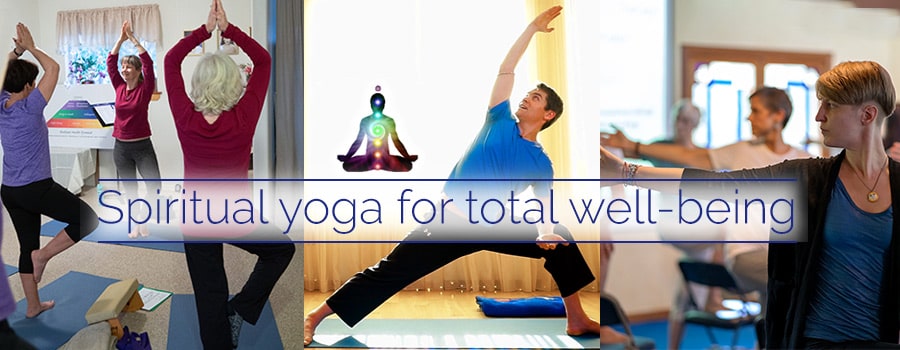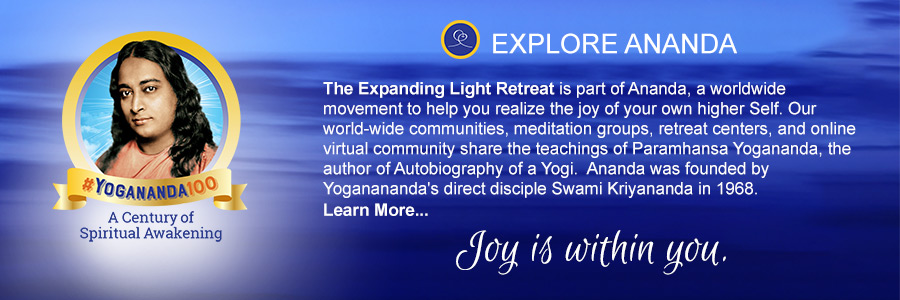Higher Awareness Comes to the Gym
This article was written for the Ananda Yoga® Teacher Association newsletter.
Learn more, or find a certified Ananda Yoga® teacher near you.
Download PDF (657kb)
Süheyla graduated from Ananda Yoga Teacher Training in January 2005, but her full-time job kept her from teaching regularly until January 2010. (She did, however, land a guest spot teaching Ananda Yoga on a popular Turkish national television show!) She now teaches yoga and pilates at Mars Athletic Club in Istanbul. In Summer 2010 while Süheyla was at Ananda’s retreat center, The Expanding Light, for more training, Gyandev McCord heard how she has brought real Ananda Yoga—including its spiritual dimension—to the gym, and he asked her to share her story via an interview. Many thanks to Bliss Wood (Ananda YTT, Summer 1999) for transcribing the interview.
Gyandev: How did all this begin?
Süheyla: I worked out at the club, and they asked me to start teaching. I hesitated because I didn’t think I could use there what I have learned at Ananda. But my heart said, “Go for it. If it doesn’t work, you can always find another job.” Management was more interested in me teaching pilates, as it was more profitable for them. They told me: “Don’t put much effort into yoga; it has never been popular here. Try to attract the members to your pilates classes.”
At first they gave me time slots that other teachers didn’t want: like Sunday noon, when everybody is with family, or Friday morning at 7:30 AM—not great because Thursday night is party night. I kept affirming, “God will help me, and if not, then I am not meant to be there.”
Were the club members receptive?
Not at first, because they did not know me, and because they were used to a “yoga workout,” while my class was slower. Some said, “I’d rather sweat and get the most of my hour here.” Most were very restless and angry after dealing with troubles at work and spending hours in the traffic. I had to be flexible, and not teach the way I practice. I thought, “Okay, if they want a workout, let’s have a workout! I’ll gradually draw them into a deeper practice.”
I started my classes with 10–15 of the Energization Exercises, then Surya Namaskar (Sun Salutation). The Surya Namaskar affirmation is very beautiful (see below), and everyone quickly got into it. As they began to calm down, I would transition into a classic Ananda Yoga sequence.
In the beginning, only three to five people came—all women—but they began telling others how much they liked it, and within four or five months, we were up to 20 people. They say they love the “beautiful sayings” (mainly, the affirmations). I do a lot more than just repeat the affirmations. For instance, in Warrior II, I might say: “We all have many obstacles in life, but how do we want to be? Strong! We can deal with these obstacles, right? Now, let’s see strong warriors who will face every obstacle with strength and power.” Then I offer the affirmation—“I joyfully manifest the power of God!”—to help them be that way. They love the way Ananda Yoga incorporates the mind. Many say that they’ve never had s spiritual yoga practice before. They’re surprised that a style like Ananda Yoga exists. [laughs]
The affirmations help me, too. I’m not just repeating them for the students’ sakes. They give me more inspiration, and the whole class flows. I have higher energy, even though I may have arrived at the club after two hours in traffic. Saying the affirmations and feeling the energy inspires me very much.
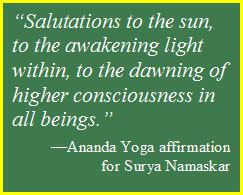
After all, if you’re not peaceful, how can you convey the vibration of peace to other people?
Exactly. And at the end of class. we do simple healing prayers. I say: “Visualize someone who needs healing—a friend, family anyone. Healers give energy with their hands. We can all do that. Rub the hands together, feel the energy in your hands, and send this person beautiful healing light.” Then I say a long, “AAAAUUUMMmmm.”
In the beginning, people were very shy to do this, especially guys. Saying AUM is not common in other yoga classes, but I think it gives a sense of completion. At first, I could only hear my own voice. [laughs] Now, we have a pretty loud crowd in the room.
Some people ask, “What does AUM mean?” And I say, “It is the same thing as amin [the Muslim version of amen]; it is God’s name.” Most of them are Muslim [as Süheyla is], and in Turkey we use amin often, but not with reference to God; it’s just an ordinary word. Now the students don’t think that chanting AUM is strange.
Sometimes with healing prayers, I’ll say: “We live close to Israel, and there is a lot of turmoil going on there. If one part of the world doesn’t have peace, how can any of us have peace? Let’s send them this beautiful energy we’ve created here.” There are both Muslims and Jews in my classes, and we may have many differences, but surely we all want peace.
The students wouldn’t have such a deep experience if there weren’t a good vibration coming through you.
Yes, knowledge is important, but it is more important as a teacher to be at peace, because only when you calm your mind can you really be a channel. After starting to teach, I realized how much we have received through Ananda; not only knowledge, but spiritual depth. It makes a big difference out there.
How have they responded to Energization?
Energization has been a key to building the magnetism. In the beginning, only women came to my classes because guys want to lift weights. Guys want to look good. and they thought that yoga is too feminine. So I wondered, “How can I get guys to come to class? They would give the class a lot of energy.” When I saw them in the gym, I would ask, “Why don’t you come to my yoga class?” They would say: “Thanks, but no. Yoga is not for us.” And I would say, “Don’t worry, I will really work you out!” [laughs]
Well, I was persistent, and they couldn’t say no forever, so finally they came. [laughs] I would really put out a lot of energy, especially in Energization. From my facial expressions to my body, there was so much energy. I don’t usually energize so outwardly, but in order for them to understand, they had to see my whole body vibrating. Soon they got into it so much that they asked me to do it every time—especially the arms sequence, which is like lifting weights. They also love 20-Part Body Recharging.
At first, they would say, “We cannot feel those body parts,” and I would say: “You will, if you really concentrate. Concentration is missing here!” [laughs a lot] They need help focusing, they need to be challenged, or else it’s not interesting for them. So I made Energization challenging for them. Sometimes I have to be very strong, push them; other times I’m quieter and more relaxed.
The guys also like the stretching aspect of the Energization Exercises, like Side-to-Side Stretching and Large Circles with the Arms—after tensing and holding, then relaxing and stretching. Their arms are so tight from lifting weights. Now my classes are half women and half men. The Energization exercises really helped that happen.
Women are more open to spirituality, so it was easier for me to get my point across to them. Men had to feel it physically—not energetically. And since I’ve been here [at The Expanding Light], I’ve learned a lot of new tips and tricks that I will use in my classes so they can feel the energy moving in their bodies. That is the most important thing, but it takes time.
You teach a reduced set of the Energization exercises?
Yes, only 15 or so because my class is only an hour long, and they have to have asanas. I tell them, “There are 39 exercises, but we will unfortunately do only 15 [laughs].” And they complain, “Why can’t we do all of them?!” To be sure they have a larger perspective, I say that these are not only 15 warm-up exercises; they are part of a system. So there is something working in their minds even though I don’t have time to teach all those exercises.
I have to admit that I had doubts teaching them at first. I learned Energization at such a spiritual place [The Expanding Light] that it was easy for me to incorporate it in to my practice. But would these people understand? But now I see, oh yeah, they really like it! It gave me more confidence teaching them.
Does the strong emphasis on Energization make it easier to bring restless people into true Ananda Yoga asana practice?
Definitely. It helps them focus. Most of them are perfectionist, so they really want to feel the energy. [laughs] It’s also a lot of fun. People live so out of their bodies that when I say, “Tense your forearm,” they have no idea how to tense and isolate only that area. It becomes like a game to them. When I say, “Tense your left lower back,” they look at me with such a face! One of them will say, “How do you tense your back?!“ And we all laugh.
It helps release their tension, doing something totally different and being aware of their bodies. I say things like, “If you cannot be aware of your body, how can you be aware of something subtler, like your feelings?” And they say, “Ah, now we have to be aware of our feelings, too!” [laughs] But they get it; they say, “That’s true.” Maybe women get more out of being aware of their feelings, but I think it is time for guys to be more aware too.
I add spiritual ideas, little by little. Knock on wood [knocks], nobody has been offended so far, because they can feel that what I say comes from my own good wishes for humanity.
You’re not trying to impose something on them. You’re very relaxed about it.
Exactly. Even though they have never meditated and they have no concept of spirituality, when they hear these things, they open up incredibly. It’s amazing that people are so hungry for this. I feel very blessed to share it.
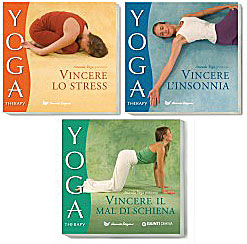 |
Süheyla has volunteered her time as a model for three yoga therapy books produced by Ananda Assisi. Clockwise from upper left: Overcome Stress, Overcome Insomnia, and Overcome Back Pain. |
With so many more people now coming to yoga classes, it’s probably even more amazing to the management than to you.
Yes, they are very amazed. Once the manager asked me, “What are you doing with them?!” [laughs] Recently the members circulated a petition to have me teach more classes! I don’t think it’s about me. If they are receiving something, it is surely Master’s [Paramhansa Yogananda’s] energy. The students say, “Thank you so much, we have received so much peace from your class,” but if you asked me how the class went, I would say, “Ahhhrghh, that wasn’t a good class.”
The management was especially amazed when parents started bringing their kids to class. That never happened before. They have a rule against kids in group classes, but I let them in anyway thinking that they would soon get bored and stopped coming, but I was wrong. Every week another parent brought a kid. Soon there were five kids, six kids, until the management told me to tell parents not to bring kids. I asked, “Did you receive any complaints?” They said, “No, but it is company policy.” But I convinced them to change their minds. Now I’m teaching kids with their consent. [laughs]
Kids give purity and softness to the class They are open to spirituality, and they like that I always have a theme of peace, or light, or energy, or love, or compassion. With the affirmations and my tone of voice, I make a story with every asana. If it were just asanas, it would be boring for them. Just doing the asanas for an hour and a half would bore me, too, if there were nothing more to the practice than the physical.
How do you prepare for your classes?
I try always to meditate. I am a Kriyaban [Kriya Yoga initiate], so I meditate at least 90 minutes every morning. And I always do my personal asana practice. Before daytime classes, I go to a park near the club and meditate for about 20–30 minutes. If students ask me where I was before class, I tell them I was meditating. I want them to hear and to know that meditation is a big part of it. Two of them have told me that they can always tell whether I’ve meditated. [laughs] That tells me I should do it all the time. Then I can for sure channel my energy better.
Have any of them asked to be taught meditation?
Yes. I told management, and they were again amazed “How can we do this? Yoga, okay, but meditation?! [laughs] The music at the club is so loud!” It is a very difficult environment for yoga, not to mention meditation. But I said, “Why not? Let’s try.”
It’s hard for students to focus, not only because of the environment, but also their restless energies. They tend to look out the window, or listen to the music outside, or talk. But I turn off the lights, and I put on my own music (usually Swami Kriyananda’s). With the affirmations, and with me urging them to focus, soon we don’t hear the music outside the room, and we forget that we are in a gym doing yoga. I plan to teach meditation, because many people are asking about it. Besides, after the class is over, most of them do not want to leave. That tells me that they are ready.
They don’t want to leave?
Yes, after the healing prayer, I always say AUM three times, and I don’t turn on the lights right away because I want people to stay in that calmness. But I do say, “There is another class coming, so can we all leave shortly?” [laughs] But they want to stay, and of course I cannot make them leave. I can feel that they are going deep. There are many sincere souls. Some look like they have been meditating for years. It has taught me not to think that in this place people cannot do yoga or meditate, because the opposite is proving true. So I will give them more than just asanas, even if management does not give me a separate time for meditation. The last fifteen minutes of my yoga class will be meditation.
You spoke earlier of the difference that Ananda Yoga brings with its emphasis on energy and consciousness. How do you bring that into your classes?
Before the class, I ask myself: “These people are tired, restless, unhappy. Many have a lot of anger. What can I do?” To answer that, I think: “What makes me feel better when I feel down, or low on energy? Well, lifting my eyes to the point between the eyebrows lifts my energy up. Okay, this is higher consciousness, this is more happiness.” So I have them do that as well, even in the asanas—always! I say: “Bring that energy to the point between the eyebrows; the prefrontal lobes of the brain. This is how we get more creative, sharpen the intellect, develop intuition. These are things we all want.”
I ask them to close their eyes when pausing after each asana. If some don’t want to close their eyes, I urge them: “Close the eyes, feel the calmness. Have the willingness to be calm, even if it requires effort.” It works. Ananda Yoga for Higher Awareness—that’s exactly what it is.
Yes, I’m teaching in a fitness club where most people think yoga is either too slow or too easy. And those who do yoga are used to vinyasa yoga [“flows”]. Sometimes they ask, “Why do we pause after each side or each asana?” I give a simple answer: “Because soul has to feel what body has done.” If they have more understanding, then I give them a deeper explanation. But Ananda Yoga is very flexible. You can make it tough if that’s needed—in simple ways, like: “Come down to a horizontal thigh in this Warrior Pose. Now let’s hold it for a while!”
After one class, some guys told me, “We lift weights for hours, but we never sweat this much.” [laughs] I’m not trying to make them sweat; it’s just harder than it looks. They like the challenge and the calmness they receive.
One guy told me before a Sunday class: “The rest of my day is so peaceful after this class. Some Sundays I wake up and think I should just relax, but I know I will feel very good after this class, so I come.” And he does come—every week. Feedback like this tells me that my approach is working. Even if we use just a bit of our Ananda training, people can benefit so much. We need to immerse ourselves in this teaching so we can give more.
Most people are open to spiritual things if you don’t push them.
Definitely. Six months ago if you asked me about teaching real Ananda Yoga in a gym, I would have said, “No, I’ve been in Yogananda’s teaching long enough to know that it wouldn’t work.” Well, I would have been wrong. Especially in night classes, people come very restless. There are times when I’m trying to teach, with people talking to each other and their mobile phones ringing—it’s very distracting and hard to calm that energy. Then we start with Energization, I say a couple of simple spiritual things, and the energy totally slows down.
What kind of “simple spiritual things”?
In an asana, I might say: “Let’s open our hearts. All day long, so many things may not have gone as smoothly as we would have liked, with our co-workers, with our families, and maybe our hearts have closed a bit. Do we want to open them? Let’s make this practice a way to release the tension in our hearts.”
Or during the Standing Backward Bend, I might say: “Open your hearts. It’s not easy sometimes, but let’s have the will to open our hearts. We all complain that we don’t receive enough love, but maybe our hearts aren’t open enough. Deep inside we know that it is true for all of us.”
Or, “Yoga means union—soul, body, mind. So we have to get our mind into what we are doing. We need to focus. Swami Kriyananda says that if you cannot concentrate, you cannot be successful in life.” People relate to it right away.
People want it, and they don’t know how to do it themselves. So they come to your class.
Their soul will feel it even though their intellect might not. If I couldn’t teach it this way, I would not want to teach. One feels it in the class: It’s not me doing it; it is God, the flow of energy, the vibrations. Ananda Yoga is so incredible.
I often say “Swami Kriyananda says …,” or “Yogananda says …,” because I feel that mentioning their names also brings their energy and vibration into the class, and their presence helps me somehow. [laughs]
Do you use props?
We have no yoga props in the room because yoga is like a … how do you say…?
… poor stepchild?
Exactly. No budget. I may think, “How can I possibly help without blankets or other props?” But people are so appreciative that I try. Even though we have very limited props, God always helps somehow. I try to adjust people and put something under them, like other mats—not the greatest props—but people appreciate it so much. Ananda teaches us this, to have compassion for people, help them, serve them, so when you do it with this feeling even with limited resources, it really has an effect. Sometimes it’s just a kind touch, rather than exactly what the touch is doing.
Ananda Yoga gives not only the space, but the need, for creativity in teaching. Yet with freedom comes a responsibility to be very clear in what you’re saying, not to get into airy-fairy things that mean nothing. You’re using your words to build solid bridges to help them go where you know they want to go.
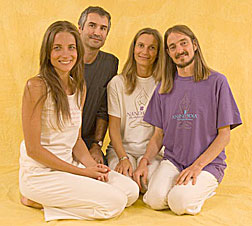 |
Production crew for the Ananda Assisi (Italy) yoga therapy books mentioned earlier in this article (l-r): Süheyla (asana model), Tejindra (designer), Sahaja (editor), Jayadev (author, director of Ananda YTT in Assisi) |
I hope so. It is a big responsibility because people do listen and take your words seriously. They don’t get this in other yoga classes. I go to other classes to get other perspectives, but nothing is spiritual in those classes. Nothing! The only focus is on doing the asanas perfectly! So my class is totally different. I think if you teach with sincerity and in a proper way, it comes out fine.
I’m sure it helps that you are in a Mediterranean culture, where people are more heart-centered. You might need a different approach in, say, Scandinavia.
Definitely. We have faith in God. We are Muslims, but a lot of Jews come to my classes as well. I say things from Swami Kriyananda, Paramhansa Yogananda, Rumi and other Sufi masters. I say: “These souls they came to bring us happiness, peace. They’re all saying the same thing.” I try to get everybody into the feeling of union. I say, “That is why we are here, because we want this union—with each other, with the people around us.” I try to give the message of unification (or becoming united) as much as I can, and people really like it. Kriya Yoga gives me a lot of strength to do this; if I weren’t part of Ananda and weren’t meditating, I don’t think it would flow like this.
You’re very alone in Istanbul, spiritually. How do you stay recharged?
I go regularly to Ananda Assisi [Italy], and to The Expanding Light whenever I can. I want to say to all teachers who read this interview: “Please come and visit Ananda on a regular basis. Take some classes. It will help so much in your teaching”
Yes, everyone needs new input. We all get stuck in patterns, and we know it. You’re showing people how to break those patterns. You come here to get recharged, and they come to you to get recharged. I’m sure that many of them pass it along to others, through the feeling with which they leave your class.
Yes, people leave the class with a different awareness. At first, nobody was interested in yoga philosophy. Then some started to ask, “Can you recommend any books about yoga?” Some things open up their hearts and they get interested. Maybe in the beginning it was only a physical thing, and they weren’t interested in knowing more. But when they experienced spirituality, they started to open up. Experience, that’s what does it.
I have had many challenges—my lack of teaching experience, the difficult people, the difficult teaching environment—but all of it has made me stronger. I am sure it will help me even more in the future. I love to teach and share what I know; that’s what inspires me. I’m so grateful that God has given me this opportunity to do something I enjoy, and that changes my life, and helps others change theirs.
Learn More About Ananda Yoga
- Find a certified Ananda Yoga teacher near you
- Read about Ananda Yoga Teacher Training programs
All authors are graduates of Ananda Yoga Teacher Training.
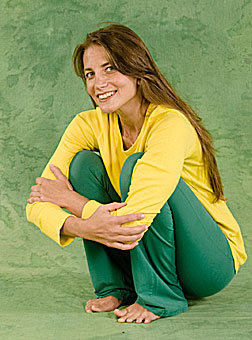
Süheyla Kanca



